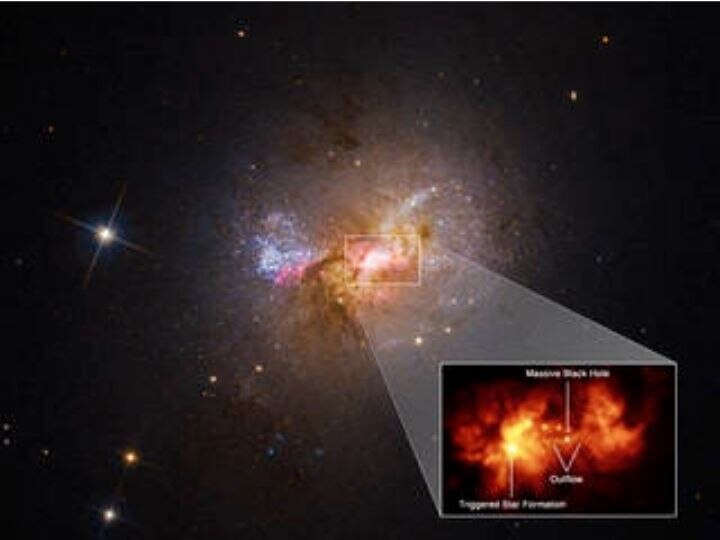Explorer
A NASA Breakthrough: Hubble Finds Black Hole That Is Creating Stars And Not Engulfing Them
NASA's Hubble Space Telescope has recently discovered a black hole at the heart of the dwarf galaxy Henize 2-10.

Representative image of black hole | Photo: Getty
New Delhi: Black Holes are often portrayed as destructive monsters that hold light captive. However, in the latest research from NASA's Hubble Space Telescope, black holes take on a less villainous role.
Hubble has recently discovered a black hole at the heart of the dwarf galaxy Henize 2-10, which is creating stars rather than engulfing them. The study, conducted by researchers from the Montana State University in the United States, was recently published in the journal, Nature.
Dwarf Galaxy Is Located 30 Million Light Years Away From Earth
According to the study, the dwarf galaxy lies 30 million light-years away from Earth, in the southern constellation Pyxis. Apparently, the black hole is contributing to the firestorm of new star formation occurring in the galaxy.
Galaxies which have active galactic nuclei (small region at the centre of a galaxy that emits large amounts of energy in the form of radio, optical, X-ray, gamma radiation, or high-speed particle jets) exhibit black-hole driven outflows.
These events probably play a major role in heating and expelling gas, thereby suppressing star formation, as they do in larger galaxies, the study said.

Henize 2-10 Is A Starbust Galaxy
Henize 2-10 is a dwarf starbust galaxy (a galaxy undergoing exceptionally high rate of star formation) previously reported to have a central massive black hole, according to the study. However, the interpretation has been disputed because some aspects of the observational evidence are consistent with a supernova remnant.
The galaxy set off a debate among astronomers, a decade ago, about whether dwarf galaxies harboured black holes proportional to the supermassive behemoths found in the hearts of larger galaxies.
How Henize 2-10 Can Help Solve Mystery Of Origin Of Supermassive Black Holes
Henize 2-10, which contains only one tenth the number of stars found in our Milky Way Galaxy, can play a major role in solving the mystery of where supermassive black holes came from in the first place, NASA said on its website.
The galaxy presents an opportunity to determine if there is evidence for a black hole outflow influencing star formation. There is a 150 parsec (489.235 light years) long ionised filament connecting the region of the black hole with a site of recent star formation, the study said.
Any Reines, the principal investigator of the study, and who published the first evidence for a black hole in the galaxy in 2011, said that Hubble has provided a very clear picture of the connection between the black hole and a neighbouring star forming region located 230 light-years away from the black hole, according to a NASA statement.
The connection is an outflow of gas stretching across space like an umbilical cord to a bright stellar nursery, according to NASA.
What Did Hubble Observe?
Hubble spectroscopy showed that the outflow was moving about one million miles per hour, slamming into the dense gas like a garden hose hitting a pile of dirt or spreading out.
Also, newborn star clusters dot the path of the outflow spread.
However, this is opposite of what is observed in larger galaxies, NASA said in its website. Material falling towards the black hole in larger galaxies is whisked away by surrounding magnetic fields, forming blazing jets of plasma moving at close to the speed of light. When gas clouds are caught in the jets' path, they are heated far beyond their ability to cool back down and form stars.
How Is Star Formation Different In Large & Small Galaxies?
However, in smaller galaxies with a less massive black hole, such as Henize 2-10, gas was compressed just enough to precipitate new star formation, according to the study. Also, the outflow in smaller galaxies is gentler compared to that in larger galaxies.
Zachary Schutte, the lead author of the study, said that Henize 2-10, at only 30 million light-years away, is close enough that Hubble was able to capture both images and spectroscopic evidence of a black hole outflow very clearly. Schutte added that the additional surprise was that rather than suppressing star formation, the outflow was triggering the birth of new stars.
How Did Researchers Confirm The Presence Of A Black Hole At The Galactic Centre?
Reines explained that the cosmic entity at the centre of Henize 2-10 could not be supernova remnant because corkscrew-like patterns shown by Hubble's resolution in the velocities of the gas can be fit to the model of a wobbling outflow from a black hole, and a supernova remnant would not have that pattern.
In the future, more research will be directed at dwarf galaxy black holes, with the aim of using them as clues to the mystery of how supermassive black holes came to be in the early universe, Reines expects.
How Mass Of A Galaxy Determines Black Hole Mass
The relationship between the mass of the galaxy and its black hole can provide clues, the NASA statement said. While Henize 2-10 has a black hole of around one million solar masses, larger galaxies can have black holes more than one billion times our Sun's mass. The more massive the host galaxy, the more massive the central black hole.
Categories To Describe Black Hole Origin
According the current theories, the origin of supermassive black holes is broken down into three categories. The first category includes smaller stellar-mass black holes formed from the implosion of stars, and which somehow gathered enough material to grow supermassive.
The second way in which supermassive black holes are thought to have originated includes special conditions in the early universe which allowed for the formation of supermassive stars, and collapsed to form massive black hole "seeds".
The third category takes into consideration the seeds of supermassive black holes born in dense star clusters, where the cluster's overall mass would have been enough to somehow create them from gravitational collapse, NASA said on its website.
Dwarf Galaxy Black Holes Can Serve As Analog For Black Holes In Early Universe
Dwarf galaxies like Henize 2-10 provide promising potential clues about the origin of supermassive black holes, because they have remained small over cosmic time, and did not undergo the growth and mergers of large galaxies like the Milky Way.
According to astronomers, dwarf galaxy black holes can serve as analog for black holes in the early universe, when they were just beginning to form.
Reines said that dwarf galaxies may retain some memory of the black hole seeding scenario that has otherwise been lost to time and space.
Related Video
Southern Rising Summit 2024: How Important is Self-Awareness? Insights from Anu Aacharya | ABP LIVE
Follow Science News on ABP Live for more latest stories and trending topics. Watch breaking news and top headlines online on ABP News LIVE TV

Dr Prosenjit NathThe writer is a technocrat, political analyst, and author.
Opinion





































